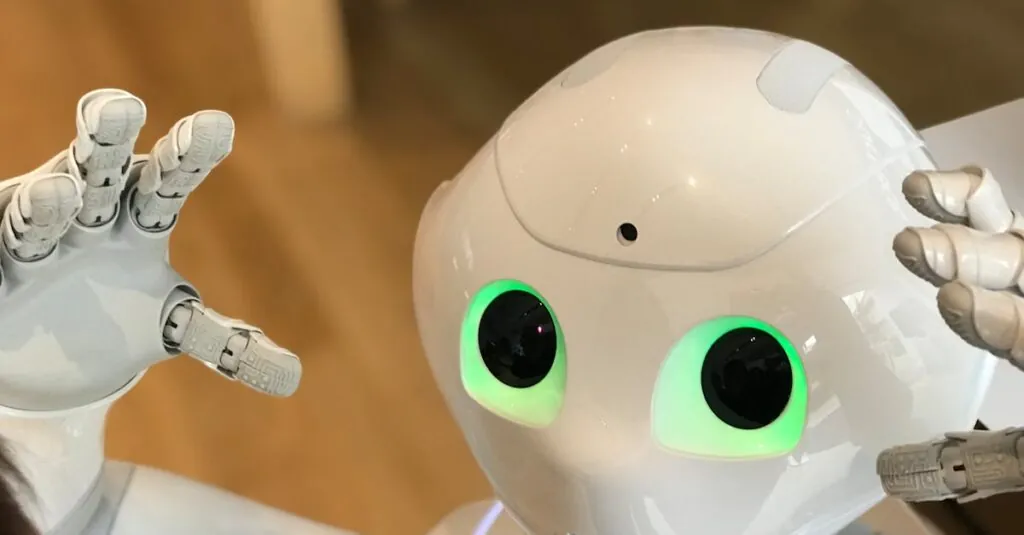Table of Contents
ToggleImagine a world where robots not only do your chores but also crack jokes better than your uncle at family gatherings. Intelligent robots are no longer the stuff of sci-fi movies; they’re rapidly becoming part of our daily lives. From self-driving cars to chatty virtual assistants, these mechanical marvels are here to make life easier and a bit more entertaining.
Overview of Intelligent Robots
Intelligent robots significantly impact various sectors, employing sophisticated algorithms to understand and interact with their environments. These machines utilize artificial intelligence, enabling them to learn from experiences and improve their performance over time. Self-driving cars exemplify this technology; they navigate complex road systems and adapt to changing conditions, ensuring passenger safety.
Virtual assistants showcase another aspect of intelligent robots. They process natural language, allowing users to make requests and receive information hands-free. Smart home devices, such as thermostats and security systems, integrate with virtual assistants, streamlining home management.
Industries also benefit from intelligent robots. Manufacturing processes leverage robotic automation to increase efficiency and precision. Robots assemble products, manage inventory, and conduct quality assessments, reducing human error.
Healthcare relies on intelligent robots for various applications. Surgical robots assist surgeons with precision tasks, enhancing patient outcomes. Robots also facilitate patient care, helping with monitoring and rehabilitation.
Data management and analysis represent another area where intelligent robots excel. They analyze vast datasets, identifying patterns and trends that inform decision-making. Businesses utilize this information to create targeted marketing strategies and improve customer satisfaction.
Sectors like agriculture deploy intelligent robots for tasks such as harvesting, planting, and monitoring crop health. By employing drones, farmers gather data on crop conditions, enabling more informed agricultural practices.
The rise of intelligent robots enhances productivity, efficiency, and safety across multiple domains, shaping a future where humans collaborate with machines effectively.
Types of Intelligent Robots
Intelligent robots come in several forms, each designed for specific roles. These classifications illustrate their unique capabilities and applications across various domains.
Industrial Robots
Industrial robots dominate manufacturing lines worldwide. They perform repetitive tasks such as welding, painting, and assembly with high precision. Advanced models include computer vision systems that enable real-time adjustments to enhance productivity. For example, robots equipped with machine learning algorithms learn from past operations, leading to continuous improvement. This adaptability translates to fewer errors and reduced waste. Moreover, these robots enhance worker safety by handling hazardous materials, allowing humans to focus on complex problem-solving tasks.
Service Robots
Service robots cater to diverse sectors, including healthcare and hospitality. They assist with routine tasks like cleaning, delivering supplies, or providing information. In healthcare, robotic systems aid medical staff by transporting equipment or even assisting during surgeries. For instance, some service robots utilize artificial intelligence to engage with patients, providing companionship while monitoring vital signs. In hospitality settings, robot concierges offer guests personalized recommendations, enhancing the overall experience. Such versatility streamlines operations and elevates service quality across multiple industries.
Autonomous Vehicles
Autonomous vehicles redefine transportation through sophisticated navigation systems. Using a suite of sensors and cameras, these vehicles interpret their surroundings to operate safely without human input. They adapt to changing road conditions and optimize routes in real time to enhance passenger safety. Data-driven algorithms enable improvements in traffic management, potentially reducing congestion. For example, self-driving taxis are already in use in various cities, providing efficient and reliable rides. Continuous advancements in this technology suggest a future where autonomous vehicles seamlessly integrate into everyday life, transforming urban mobility.
Technologies Behind Intelligent Robots
Intelligent robots rely on several key technologies that enable their advanced capabilities. The integration of these technologies allows robots to navigate and interact with their environment effectively.
Artificial Intelligence
Artificial intelligence (AI) forms the backbone of intelligent robots. AI algorithms allow these machines to process vast amounts of data and make decisions based on that information. Through natural language processing, robots can understand spoken commands and engage in conversations. AI enhances learning, enabling robots to improve their performance over time by analyzing feedback from their environment. This technology drives innovations like self-driving cars, which rely on AI to interpret road conditions and ensure passenger safety.
Machine Learning
Machine learning empowers intelligent robots to adapt and evolve. Robots utilize machine learning models to analyze patterns in data, optimizing their functions through experience. Each interaction provides valuable insights, leading to refined algorithms that enhance efficiency. Autonomous vehicles, for instance, employ machine learning to predict potential hazards on the road, thereby improving decision-making in real-time situations. Continuous data collection contributes to the development of machine learning, ensuring that robots become smarter and more reliable over time.
Sensor Technologies
Sensor technologies play a crucial role in the functionality of intelligent robots. These sensors facilitate real-time data collection, allowing robots to perceive their surroundings accurately. Various types of sensors, including cameras, lidar, and radar, contribute to an enhanced understanding of environmental context. Robots use this sensory data to navigate complex environments, avoiding obstacles and reacting to dynamic conditions. In agriculture, sensor technologies help monitor crop health, ensuring that farmers receive timely insights to optimize yields.
Applications of Intelligent Robots
Intelligent robots find applications across various sectors, significantly enhancing efficiency and effectiveness.
Manufacturing
In manufacturing, intelligent robots are integral to production lines. They perform repetitive tasks with high precision, ensuring consistency in product quality. Automation of assembly processes reduces labor costs and minimizes human error, leading to improved output. Safety levels increase as robots handle hazardous materials, decreasing the risk of workplace accidents. Moreover, these machines can operate continuously, maximizing productivity during peak hours. As businesses adopt robotic solutions, the impact on overall efficiency becomes evident.
Healthcare
Healthcare harnesses intelligent robots for various critical functions. Surgical robots assist surgeons in performing intricate procedures with unmatched precision, enhancing patient outcomes. These robots provide minimally invasive options, reducing recovery times for patients. Beyond surgery, robots also assist in routine patient care and rehabilitation, offering support with mobility and medication management. With the inclusion of AI, robots analyze patient data for personalized care recommendations, streamlining workflow for healthcare professionals. The integration of these systems into healthcare practices revolutionizes patient management.
Household Assistance
Household assistance benefits significantly from intelligent robots. Robot vacuums autonomously clean floors, allowing users to focus on other tasks. Smart home devices, integrated with virtual assistants, simplify daily chores through voice-activated controls. Additionally, lawn care robots maintain gardens efficiently, adapting to varying terrain types. They operate with precision, providing homeowners with consistently manicured lawns. With the enhancement of convenience, these robots redefine household management, contributing to a more organized lifestyle.
Challenges and Ethical Considerations
Intelligent robots present various challenges and ethical considerations that demand attention. Two significant areas of concern involve job displacement and privacy issues.
Job Displacement
Job displacement often arises due to the automation capabilities of intelligent robots. Many industries experience shifts as robots perform tasks previously completed by humans. Labor-intensive positions in manufacturing see a decline as machines take over repetitive duties, enhancing efficiency. Workers in sectors like retail and logistics also face challenges as robots streamline operations. This disruption necessitates reskilling programs to help the workforce adapt to new roles. As automation increases, economic implications emerge, requiring careful planning to balance productivity with employment opportunities.
Privacy Concerns
Privacy concerns significantly impact the integration of intelligent robots in everyday life. Data collection becomes routine as these devices gather user information to enhance functionality. Surveillance capabilities in applications, like smart home assistants, raise questions about consent and data security. Users may not fully understand how their personal information gets utilized or shared. Transparent policies become essential for building trust between consumers and manufacturers. Addressing these issues ensures that the benefits of intelligent robots don’t compromise user privacy rights.
The rise of intelligent robots marks a transformative shift in how society interacts with technology. These machines are not just tools; they’re becoming integral partners in various sectors, enhancing efficiency and safety. As they continue to evolve through advanced AI and machine learning, their potential to improve everyday life and industry operations is immense.
However, with these advancements come challenges that require careful consideration. Addressing job displacement and privacy concerns is crucial for fostering a harmonious relationship between humans and robots. As intelligent robots become more prevalent, it’s essential to navigate these complexities thoughtfully to ensure a future where both technology and society thrive together.




